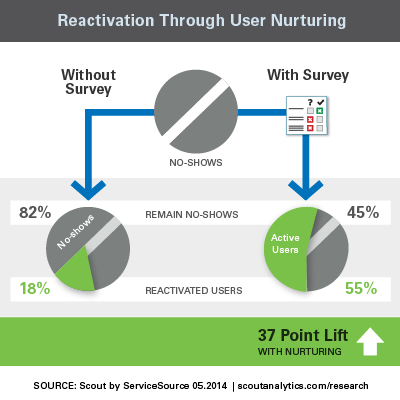User nurturing can have a big positive impact on both adoption and customer success, as we’ve discussed in earlier research alerts.
But user nurturing can also be critical to retention. Like so many customer dynamics, churn starts gradually—and if left unnoticed, it can develop into issues that are impossible to resolve.
Assuming you’ve been able to achieve your implementation and adoption milestones, any customer and revenue churn usually starts with user churn. User churn (i.e., loss of users) is when individuals start to drift away from using your solution.
At renewal time, this drop in usage results in seat churn (i.e., loss of quantity on renewal), which is the first loss of revenue. Ultimately, further usage drops can result in product churn (i.e., loss of subscription) and then customer churn (i.e., loss of customer relationship).
So how do you get ahead of this negative cycle? One leading indicator of churn is when an active user becomes a “no-show.” This event is the perfect time to intervene early and automatically with user nurturing—so you can stem the churn tide and ensure each user is receiving value.
Consider the following example. One company recently implemented a program which sent a three-question survey to active users who had become no-shows. The survey essentially said:
Our records show you haven’t logged in recently.
- Is there something we can help you with?
- Are you satisfied with our product?
- Can we provide a one-on-one session with our experts?
The response to each question determined the next steps in user engagement. For example, if a user answered that they didn’t remember their login information, they were satisfied with the product, and didn’t want a one-on-one session, the user received an automated login reset.
If a user answered that they were simply an infrequent user, they were satisfied, and they didn’t want a one-on-one session, the user was flagged as not at risk with no further nurturing needed.
If a user answered that the product didn’t have what they needed, they weren’t satisfied, and they didn’t want a one-on-one session, then a customer success manager was automatically assigned a task to follow up directly.
Of course, there were many other combinations and actions. So what was the impact?
Prior to using the survey, there was an 82% chance that when an active user became a no-show, they stayed a no-show, with only 18% becoming active again later. That 18% represents the group that is likely to be simply infrequent users.
After using the survey, the company saw a significant change: no-show reactivation more than tripled, from 18% to 55%—a 37-point lift from a simple survey. And this was only phase one. The company is currently refining the survey in hopes of growing reactivation even further.
The implication
Churn starts small, with individual users. Churn prevention should also start with individual users. By identifying the early signals of churn and then automating engagement, you can retain more users, create more value, and ultimately retain more revenue and customers.






